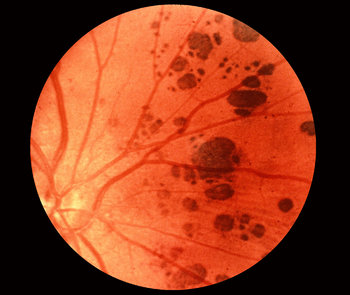

Both solitary CHRPE and its multifocal variant. This is much lower than would be expected from a survey of patients with the typical fundus lesions seen with familial adenomatous polyposis. This appearance resembles an animal paw or footprint, and thus they are commonly referred to as bear tracks. Among more than 2000 of their blood relatives, only 20 had intestinal polyposis or colonic cancer (1%). Of the 132 patients with previously diagnosed CHRPE, there were none with familial adenomatous polyposis, Gardner syndrome, or intestinal cancer, and only one patient had a history of intestinal polyps. It is believed that these spots may develop. Groups of the spots, as seen here, are commonly referred to as 'polar bear tracks' due to their color and resemblance of animal footprints.

Patients and their physicians were contacted by telephone to complete a detailed questionnaire designed to detect signs or symptoms of familial adenomatous polyposis or Gardner syndrome among these patients with CHRPE and their relatives. Congenital albinotic spots of the retinal pigmented epithelium (CASRPE) can be configured in solitary or grouped configurations. Review of charts and follow-up studies were performed on all patients diagnosed and coded as having solitary CHRPE or its multifocal variant (congenital grouped pigmentation bear tracks). This study was undertaken to determine whether the typical lesions of CHRPE, seen frequently by ophthalmologists, also were indicators of familial adenomatous polyposis. Congenital grouped albinotic retinal pigment epithelial spots (CGARPES), or polar bear tracks, is a rare anomaly characterized by multiple grouped, white, variably sized, albinotic spots. The condition is benign, although it may cause. Although atypical, such lesions have been called congenital hypertrophy of the retinal pigment epithelium (CHRPE). Last modified by Joshua Friedman on Nov 9, 2022. The bear tracks (dark blotches) are due to congenital hypertrophy of the retinal pigment epithelium (CHRPE). Philadelphia: Lippincott Williams & Wilkins 2008.It has been recently documented that multiple bilateral pigmented lesions at the level of the retinal pigment epithelium may be an indicator of patients with familial adenomatous polyposis who are prone to develop intestinal cancer, particularly if there is a positive family history of these intestinal disorders. Intraocular tumors: an atlas and textbook. When comparing front and rear tracks, the fore prints of all members of the dog family are significantly larger than the hind print. Solitary congenital hypertrophy of the retinal pigment epithelium. Congenital hypertrophy of the retinal pigment epithelium. Fluorescein angiography demonstrates blocked choroidal fluorescence by the hypertrophied RPE and no leakage of dye. Generally located in the peripheral but may occasionally in the peripapillary region.

Pediatric ophthalmology and strabismus, vol. Multiple areas of grouped CHRPE simulating the animal foot-print are also called 'bear tracks'.

A unique presentation of grouped congenital hypertrophy of the retinal pigment epithelium. Compared to retinal pigmented epithelial cells (RPE), CHRPE cells are columnar to cuboidal and are taller than the unaffected RPE. When there is an isolated lesion, we are not concerned about the association with polyps or bowel cancer. Detection of CHRPE is often the earliest clinical indicator for Gardner syndrome. However, this occurs when there are multiple CHRPE lesions called 'bear tracks,' not with a single isolated CHRPE spot. In: Singh AD, Damato BE, Pe’er J, et al., editors. Answer: There is a rare condition where CHRPE lesions are associated with colon polyps that can be cancerous. Diffuse bear-track retina: profound, bilateral, grouped congenital pigmentation of the retinal pigment epithelium in an infant. Home Recognizing Pathology Bear Tracks Bear tracks (animal tracks, grouped pigmentation spots) are simply many small CHRPEs located in isolated small area of the retina. Tumors of the retinal pigment epithelium. Methods: Review of charts and follow-up studies were performed on all patients diagnosed and coded as having solitary CHRPE or its multifocal variant (congenital grouped pigmentation bear tracks).


 0 kommentar(er)
0 kommentar(er)
